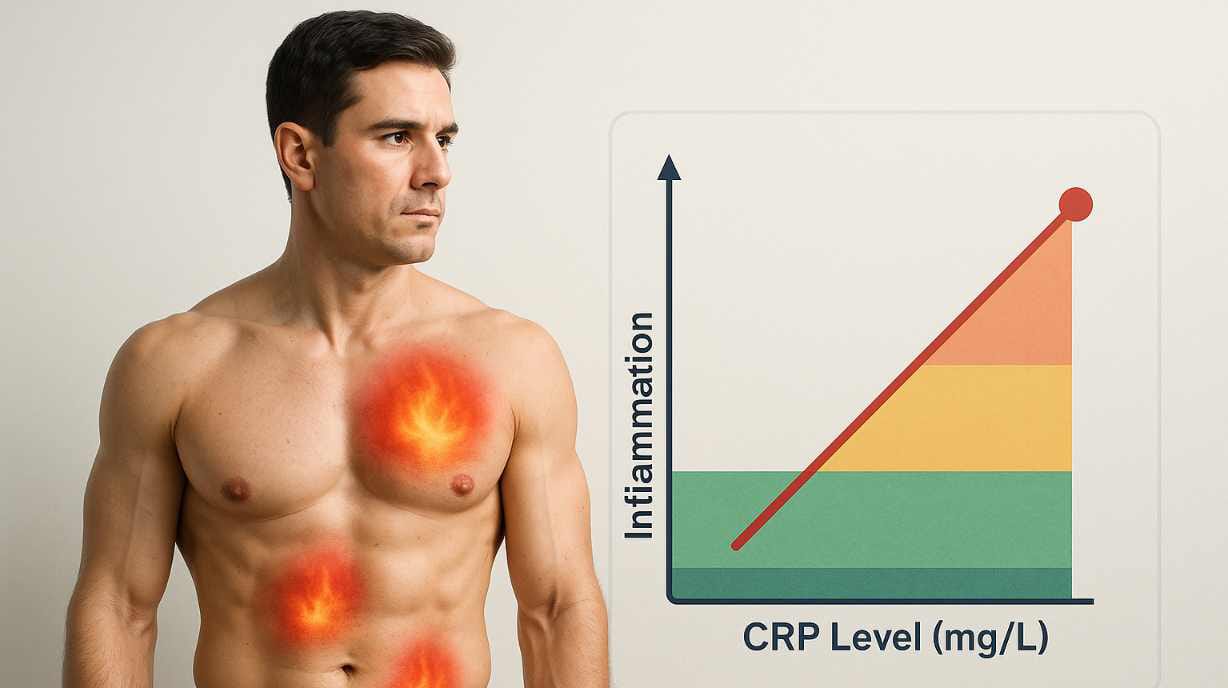Introduction
C-reactive protein (CRP) is one of the most overlooked but powerful biomarkers in modern medicine. While many people focus on blood pressure, cholesterol, or blood sugar levels, your CRP level can quietly reveal the presence of systemic inflammation—a root cause of many chronic diseases including heart disease, cancer, diabetes, and even depression.
Table of contents
Produced by the liver in response to inflammation, CRP offers a unique window into your body’s internal health. When inflammation occurs—whether due to an infection, injury, or chronic illness—CRP levels rise. But unlike many other markers, CRP can elevate long before symptoms appear, making it a vital early warning signal.
According to the Mayo Clinic, elevated CRP is associated with an increased risk of heart attack, stroke, and cardiovascular death
Source: Mayo Clinic
What Is CRP (C-Reactive Protein)
CRP is a protein your liver produces and releases into the bloodstream in response to inflammation. In medical terms, it’s known as an acute-phase reactant. This means it reacts quickly to injury, infection, or inflammation, making it a fast, reliable indicator of your body’s immune response.
There are two main types of CRP tests:
- Standard CRP test – used to detect major inflammation from severe infections or autoimmune diseases
- High-sensitivity CRP (hs-CRP) – detects low levels of inflammation and is often used to evaluate the risk of cardiovascular disease
Why Is Inflammation So Dangerous
Inflammation is your body’s natural defense mechanism. When you get injured or infected, your immune system activates inflammation to protect and heal.
However, when inflammation becomes chronic, it turns from a protective mechanism into a destructive one.
Chronic inflammation is linked to
- Atherosclerosis
- Type 2 diabetes
- Obesity
- Alzheimer’s disease
- Autoimmune disorders
- Depression
- Certain cancers
CRP acts like a smoke detector for this invisible fire.
What Is a Normal CRP Level
According to the American Heart Association, hs-CRP test results are categorized as follows:
| hs-CRP Level (mg/L) | Risk Level |
|---|---|
| Less than 1.0 | Low risk |
| 1.0 to 3.0 | Moderate risk |
| Greater than 3.0 | High risk |
If your CRP level is persistently elevated, you should investigate further—even if you feel fine. Silent inflammation can quietly damage blood vessels, organs, and tissues over time.
Why You Should Test Your CRP Level
Here’s why everyone, especially adults over 30, should consider testing their CRP level
Early Detection of Heart Disease
CRP doesn’t just detect inflammation—it predicts future heart attacks.
A 2002 study in the New England Journal of Medicine showed that individuals with high CRP levels had twice the risk of a heart attack compared to those with low levels
Source: NEJM
In fact, hs-CRP is considered one of the most reliable predictors of cardiovascular events, even more so than cholesterol in some cases.
Monitoring Autoimmune Conditions
If you have rheumatoid arthritis, lupus, or inflammatory bowel disease, CRP testing helps monitor flare-ups and track treatment effectiveness. Rising CRP levels can indicate a need to adjust medication or therapy.
Post-Infection or Illness Recovery
CRP can help track your body’s healing process after infections like COVID-19, pneumonia, or bacterial illnesses. If your CRP stays elevated, it may suggest prolonged inflammation or complications.
Studies have linked high CRP levels with severe COVID-19 outcomes, making it a key marker for hospitalization risk
Source: PubMed Central
Assessing Chronic Disease Risk
Chronic, low-grade inflammation is a hallmark of modern health problems. Even if you’re symptom-free, a CRP test can reveal hidden risks—giving you a head start on lifestyle changes before disease develops.
Also Read: Breaking the Illusion: How Porn is Quietly Destroying Your Body and Legacy
What Causes Elevated CRP Levels
Your CRP level doesn’t rise without reason. Here are the top contributors
Chronic Inflammation Sources
- Obesity or excess belly fat
- Smoking
- Sedentary lifestyle
- Sleep apnea
- High-stress levels
- Gut dysbiosis
Acute Infections or Injuries
- Viral or bacterial infections
- Wound healing
- Post-surgical inflammation
Autoimmune Diseases
- Rheumatoid arthritis
- Lupus
- Psoriasis
- Crohn’s disease
How to Lower Your CRP Levels Naturally
CRP levels are reversible. If yours is elevated, these strategies can significantly reduce systemic inflammation
Adopt an Anti-Inflammatory Diet
Eat more:
- Leafy greens, berries, turmeric, olive oil, fatty fish, and nuts
Avoid:
- Processed sugars, refined carbs, trans fats, and seed oils
The Mediterranean diet has been shown to lower CRP levels significantly
Source: Harvard Health
Exercise Regularly
Aim for at least 150 minutes per week of moderate aerobic exercise. Resistance training also helps reduce inflammation and insulin resistance.
Prioritize Sleep
Sleep deprivation is directly linked to elevated CRP. Adults need 7 to 9 hours of quality sleep for optimal immune function.
Manage Stress
Chronic stress releases cortisol, which increases inflammation. Try
- Meditation
- Breathwork
- Journaling
- Nature walks
Quit Smoking and Reduce Alcohol
Both raise CRP significantly. Eliminating them can lower levels in just weeks.
When to Talk to Your Doctor
You should consider a CRP test if you
- Have a family history of heart disease or stroke
- Are overweight or have metabolic syndrome
- Have autoimmune symptoms such as joint pain, fatigue, or skin rashes
- Recently recovered from a major infection
- Feel “off” despite normal blood work
Ask for a high-sensitivity CRP test, not the standard CRP test, for heart-related insights.
Your CRP Level Is a Silent Lifeline
You can’t see inflammation, but it’s silently shaping your future health. CRP offers a powerful and inexpensive glimpse into the internal fire that could one day spark disease.
By testing, tracking, and acting on your CRP level, you take control of your health before damage is done. Prevention is always easier than treatment.
What gets measured, gets managed. Your CRP level could be the most important number you’re not checking.
References
- Mayo Clinic – CRP Test Overview
- NEJM – CRP and Risk of Cardiovascular Events
- NIH via PubMed Central – CRP and COVID-19 Outcomes
- CDC – Chronic Disease and Inflammation





